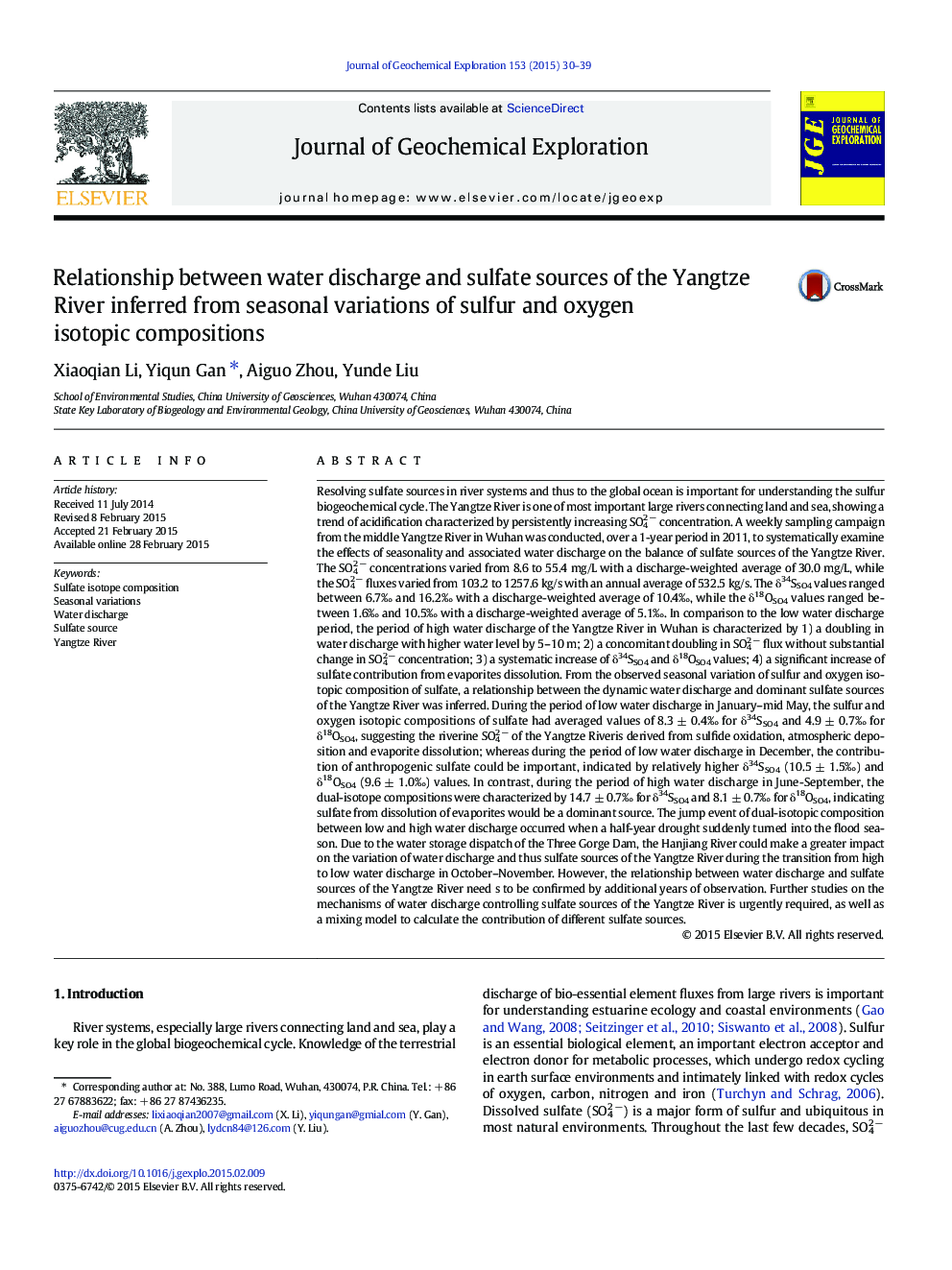| کد مقاله | کد نشریه | سال انتشار | مقاله انگلیسی | نسخه تمام متن |
|---|---|---|---|---|
| 4457153 | 1620906 | 2015 | 10 صفحه PDF | دانلود رایگان |
• Effects of seasonality and water discharge on the balance of sulfate in rivers
• A relationship between sulfate sources and water discharge
• Seasonal variations of SO42 − concentration, flux and dual-isotope compositions
• Seasonal variation of dominant sulfate sources of the Yangtze River
Resolving sulfate sources in river systems and thus to the global ocean is important for understanding the sulfur biogeochemical cycle. The Yangtze River is one of most important large rivers connecting land and sea, showing a trend of acidification characterized by persistently increasing SO42 − concentration. A weekly sampling campaign from the middle Yangtze River in Wuhan was conducted, over a 1-year period in 2011, to systematically examine the effects of seasonality and associated water discharge on the balance of sulfate sources of the Yangtze River. The SO42 − concentrations varied from 8.6 to 55.4 mg/L with a discharge-weighted average of 30.0 mg/L, while the SO42 − fluxes varied from 103.2 to 1257.6 kg/s with an annual average of 532.5 kg/s. The δ34SSO4 values ranged between 6.7‰ and 16.2‰ with a discharge-weighted average of 10.4‰, while the δ18OSO4 values ranged between 1.6‰ and 10.5‰ with a discharge-weighted average of 5.1‰. In comparison to the low water discharge period, the period of high water discharge of the Yangtze River in Wuhan is characterized by 1) a doubling in water discharge with higher water level by 5–10 m; 2) a concomitant doubling in SO42 − flux without substantial change in SO42 − concentration; 3) a systematic increase of δ34SSO4 and δ18OSO4 values; 4) a significant increase of sulfate contribution from evaporites dissolution. From the observed seasonal variation of sulfur and oxygen isotopic composition of sulfate, a relationship between the dynamic water discharge and dominant sulfate sources of the Yangtze River was inferred. During the period of low water discharge in January–mid May, the sulfur and oxygen isotopic compositions of sulfate had averaged values of 8.3 ± 0.4‰ for δ34SSO4 and 4.9 ± 0.7‰ for δ18OSO4, suggesting the riverine SO42 − of the Yangtze Riveris derived from sulfide oxidation, atmospheric deposition and evaporite dissolution; whereas during the period of low water discharge in December, the contribution of anthropogenic sulfate could be important, indicated by relatively higher δ34SSO4 (10.5 ± 1.5‰) and δ18OSO4 (9.6 ± 1.0‰) values. In contrast, during the period of high water discharge in June-September, the dual-isotope compositions were characterized by 14.7 ± 0.7‰ for δ34SSO4 and 8.1 ± 0.7‰ for δ18OSO4, indicating sulfate from dissolution of evaporites would be a dominant source. The jump event of dual-isotopic composition between low and high water discharge occurred when a half-year drought suddenly turned into the flood season. Due to the water storage dispatch of the Three Gorge Dam, the Hanjiang River could make a greater impact on the variation of water discharge and thus sulfate sources of the Yangtze River during the transition from high to low water discharge in October–November. However, the relationship between water discharge and sulfate sources of the Yangtze River need s to be confirmed by additional years of observation. Further studies on the mechanisms of water discharge controlling sulfate sources of the Yangtze River is urgently required, as well as a mixing model to calculate the contribution of different sulfate sources.
Journal: Journal of Geochemical Exploration - Volume 153, June 2015, Pages 30–39
